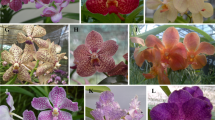Summary
Conventional propagation of amaryllis, Hippeastrum Herbert sp. hybrids by bulb offsets is slow, seasonal, and variable; additionally, some amaryllis hybrids do not produce many offsets. From seed, it takes approximately 2 yr to flower. Micropropagation of Zephyranthes L. sp. bulbs has challenges related to contamination of stage I cultures as well as genotype differences in culture media requirements. There are literature reports on in vitro propagation of both genera; however, the application of these reports to new cultivars leaves unanswered questions regarding surface disinfestation, explant, nutrient media, and multiplication rates. Surface disinfestation of container-grown Hippeastrum spp. hybrid cv. San Antonio Rose bulbs resulted in contamination rates of 20 to 100% in spite of various treatments, some of which killed the explant. Twin scale explants of San Antonio Rose bulbs responded on a Murashige and Skoog salt medium with 2 mg naphthalene acetic acid per 1, and transfer to soil was not a problem. In contrast, aseptically germinated seed of Zephyranthes sp. served as a suitable source of clean bulb tissue.
Similar content being viewed by others
References
DeBruyn, M. H.; Ferreira, D. I.; Slabbert, M. M.; Pretorius, J. In vitro propagation of Amaryllis belladonna. Plant Cell Tissue Organ Cult. 31:179–184; 1992.
Huang, C. W.; Hiroshi, O.; Uemoto, S. Importance of two scales in propagating Hippeastrum hygridum by twin scaling. Sci. Hortic. (Canterb). 42:141–149; 1990.
Hussey, G. Totipotency in tissue explants and callus of some members of the Liliaceae, Iridaceae, and Amaryllidaceae. J. Exp. Bot. 26:253–262; 1975.
Kim, K. W.; DeHertogh, A. A. Tissue culture of ornamental flowering bulbs (geophytes). Hortic. Rev. 18:87–169; 1977.
Murashige, T.; Skoog, F. A revised medium for rapid growth and bioassay with tobacco tissue culture. Physiol. Plant 15:473–497; 1962.
O’Rourke, E. N.; Fountain, W. M.; Sharghi, S. Rapid propagation of Hippeastrum bulblets by in vitro culture. Herbertia 47:54–55; 1991.
Seabrook, J. A.; Cumming, B. G. The in vitro propagation of amaryllis (Hippeastrum spp. hybrids). In Vitro 13:831–836; 1977.
Author information
Authors and Affiliations
Rights and permissions
About this article
Cite this article
Smith, R.H., Burrows, J. & Kurten, K. Challenges associated with micropropagation of Zephyranthes and Hippesatrum sp. (Amaryllidaceae). In Vitro Cell.Dev.Biol.-Plant 35, 281–282 (1999). https://doi.org/10.1007/s11627-999-0032-y
Received:
Accepted:
Issue Date:
DOI: https://doi.org/10.1007/s11627-999-0032-y




